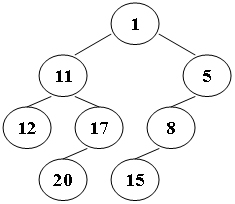Suppose that all the keys in a binary tree are distinct positive integers. A unique binary tree can be determined by a given pair of postorder and inorder traversal sequences. And it is a simple standard routine to print the numbers in level-order. However, if you think the problem is too simple, then you are too naive. This time you are supposed to print the numbers in "zigzagging order" -- that is, starting from the root, print the numbers level-by-level, alternating between left to right and right to left. For example, for the following tree you must output: 1 11 5 8 17 12 20 15.

Input Specification:
Each input file contains one test case. For each case, the first line gives a positive integer N (≤30), the total number of nodes in the binary tree. The second line gives the inorder sequence and the third line gives the postorder sequence. All the numbers in a line are separated by a space.
Output Specification:
For each test case, print the zigzagging sequence of the tree in a line. All the numbers in a line must be separated by exactly one space, and there must be no extra space at the end of the line.
Sample Input:
8
12 11 20 17 1 15 8 5
12 20 17 11 15 8 5 1
Sample Output:
1 11 5 8 17 12 20 15思路:之字型层次遍历。进行两次层次遍历,从左到右,和从右到左;从左到右比遍历,如果节点在偶数层,则将其保存起来;同样,从右到左遍历,如果该节点在奇数层,则将其保存起来。
程序:
#include <cstdio>
#include <vector>
#include <queue>
#include <unordered_map>
using namespace std;
struct node
{
int data;
struct node *lchild,*rchild;
};
struct node* create(vector<int> v1,vector<int> v2,int low1,int high1,int low2,int high2)
{
if(low1 > high1) return NULL;
struct node* root = (struct node*)malloc(sizeof(struct node));
root->data = v2[high2];
int pos = low1;
while(v1[pos] != v2[high2])
{
pos++;
}
root->lchild = create(v1,v2,low1,pos-1,low2,low2+pos-low1-1);
root->rchild = create(v1,v2,pos+1,high1,low2+pos-low1,high2-1);
return root;
}
vector<vector<int>> v(31);
unordered_map<struct node*,int> mymap;
unordered_map<struct node*,int> mmap;
int height = 0;
void l2r(struct node* root)
{
queue<struct node*> q;
q.push(root);
mymap[root] = 1;
while(!q.empty())
{
struct node * temp = q.front();
if(mymap[temp] % 2 == 0)
{
v[mymap[temp]].push_back(temp->data);
}
if(mymap[temp] > height)
height = mymap[temp];
if(temp->lchild)
{
q.push(temp->lchild);
mymap[temp->lchild] = mymap[temp] + 1;
}
if(temp->rchild)
{
q.push(temp->rchild);
mymap[temp->rchild] = mymap[temp] + 1;
}
q.pop();
}
}
void r2l(struct node* root)
{
queue<struct node*> q;
q.push(root);
mmap[root] = 1;
while(!q.empty())
{
struct node* temp = q.front();
if(mmap[temp] % 2 == 1)
{
v[mmap[temp]].push_back(temp->data);
}
if(temp->rchild)
{
q.push(temp->rchild);
mmap[temp->rchild] = mmap[temp] + 1;
}
if(temp->lchild)
{
q.push(temp->lchild);
mmap[temp->lchild] = mmap[temp] + 1;
}
q.pop();
}
}
int main()
{
int n;
scanf("%d",&n);
vector<int> in,post;
for(int i = 0; i < n; i++)
{
int data;
scanf("%d",&data);
in.push_back(data);
}
for(int i = 0; i < n; i++)
{
int data;
scanf("%d",&data);
post.push_back(data);
}
struct node* root = create(in,post,0,n-1,0,n-1);
l2r(root);
r2l(root);
int cnt = 0;
for(int i = 1; i <= height; i++)
{
for(int j = 0; j < v[i].size(); j++)
{
if(cnt == 0)
{
printf("%d",v[i][j]);
cnt++;
}
else
printf(" %d",v[i][j]);
}
}
return 0;
}





















 323
323











 被折叠的 条评论
为什么被折叠?
被折叠的 条评论
为什么被折叠?








